Samsung HW-Q800A Reviewed at $899.00
Product Name: Samsung HW-Q800A
Product Description: 3.1.2CH Dolby Atmos Soundbar
-
Design - 9/10
9/10
-
Movies Performance - 8.8/10
8.8/10
-
Music Performance - 8.8/10
8.8/10
-
Inputs and Features - 8.7/10
8.7/10
-
Price / Quality - 8.9/10
8.9/10
Summary
Reviewed at $899.00
Pros
- Dolby Atmos and DTS:X support
- Satisfying bass
- Many features
- Can be expanded to 5.1.4 channels
Cons
- SmartThings is missing a few options
- No USB playback
- Google Assistant is missing
- Surround kit adds to the overall cost
Cheapest Places to Buy :
*We are a reader-supported website. When you buy through links on our site, we may earn a small affiliate commission at no extra cost to you. Home Media Entertainment does not accept money for reviews.*
Samsung along with LG have one of the most extensive yearly lineups when it comes to the soundbar market. But it’s not just numbers as the 2021 flagship, the Samsung HW-Q950A, was one of the best performing Dolby Atmos soundbars we have tested so far. But obviously not everyone can afford such a behemoth of a soundbar so today in our Samsung HW-Q800A review we will be testing Samsung’s third in line just behind the Q950A and the Q900A.
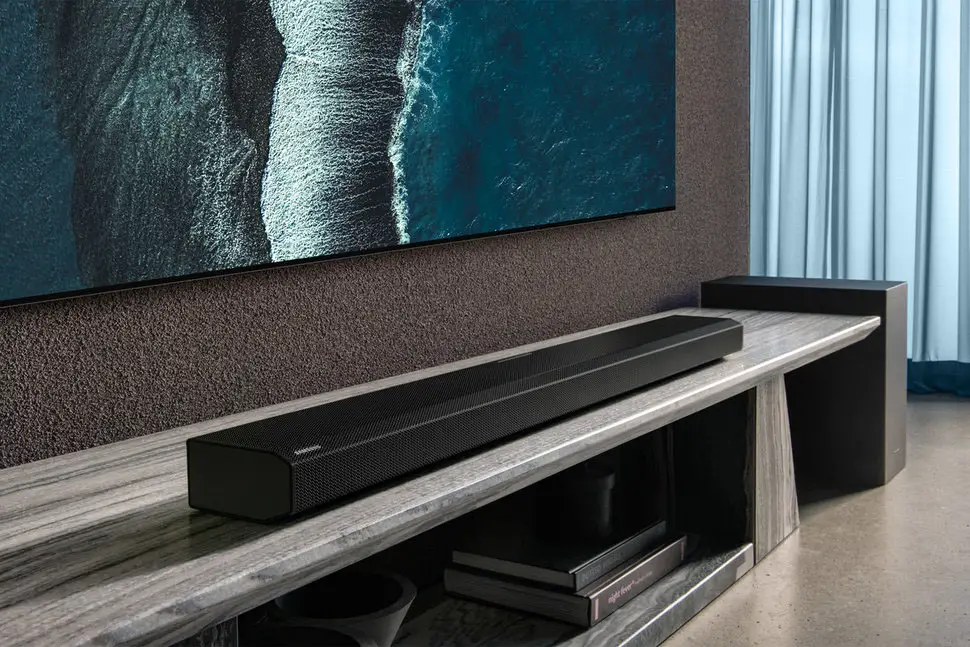
Now if you are the kind of guy that pays close attention to specs you may have noticed the remarkable similarities between the HW-Q800A we have here today and the next in line, the HW-Q700A which we had reviewed some time ago. And indeed the two soundbars are very similar with the most major change being the subwoofer, with the HW-Q800A coming with a bigger one meaning it should, in theory, perform better at the low end. Also the Q800A seems to come with Amazon Alexa built-in. But more on these shortly.
So let’s see quickly what the HW-Q800A has to offer us. The unit is a Dolby Atmos capable soundbar with a 3.1.2 channels configuration which uses, as all soundbars do, up-firing Atmos drivers for the overhead layer. There is support for both Dolby Atmos and DTS:X and has a total of 330 watts of power. It uses Acoustic Beam Technology to help project the sound upwards while in terms of extras we find Airplay 2, Amazon Alexa built-in, Q-Symphony, Tap sound and comes with the SpaceFit Sound calibration system. Lastly there is SmartThings app support and you can also expand the system with the optional SWA-9500S surround speakers kit.
The HW-Q800A is not all the different from the Q700A and many may wonder if it is worth it over its cheaper brother. With basically only the subwoofer being the most notable difference is the HW-Q800A the better choice? Let’s find out…
Design, Inputs and Features
Exterior
The main unit has extreme similarities to the HW-Q700A, so much that it is incredibly difficult to find any differences between them. As such, design and hardware wise our observations match what we saw in the Q700A. The Q800A’s footprint makes it ideal for any TV of 55″ but it can do fine with other smaller or bigger sizes also.
The soundbar measures 38.6″ x 2.4″ x 4.5″ (980.0 x 60.0 x 115.0 mm) and weights just 7.9 lbs (3.6 kg) which is normal for its category and shouldn’t be a problem moving it around. The fact that this soundbar doesn’t have any side firing drivers certainly helps as this allows for more flexibility in terms of placing it in more constraint spaces. But keep in mind that due to the Acoustic Beam technology and the up-firing Atmos drivers the top must still be unobstructed in order to work as it should.
As for its design the HW-Q800A has a very typical Samsung look with straight lines and no curves, a design that we have seen Samsung using in many of their releases. A perforated metallic grille is covering most of the front and top sides while the angled corners make its look just a bit more interesting. The rest of the main body is made out of the usual black plastic which looks sturdy and of good quality.
As was the case with the Q700A, the HW-Q800A comes with a full functions display that is placed on the far right side under the metal grille. The display is a bit small with only a few characters able to fit, four to be precise, so for longer messages you will have to wait for them to scroll which can be a bit of a frustrating procedure. But definitely a better one than some other, less ideal, display implementations.
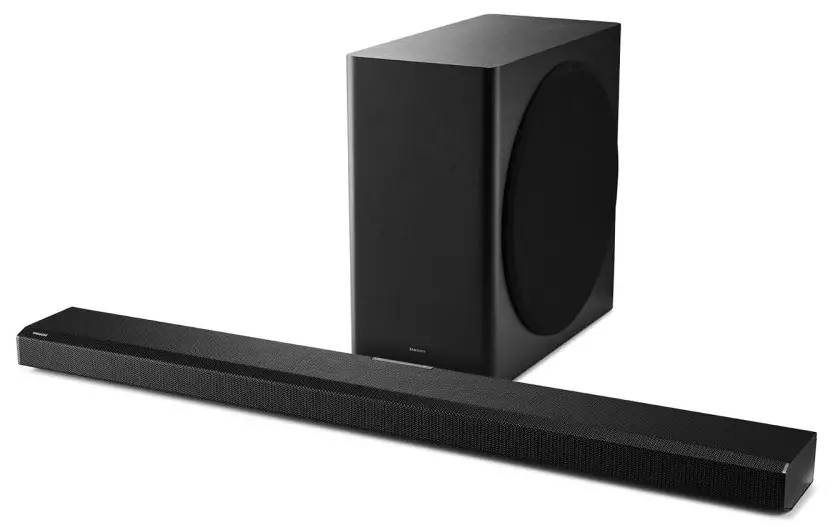
On the top side there are a handful of built-in control buttons, as per usual, while on the back we find two big insets covering all the available ports which we will analyze in the appropriate section.
It seems that while for the main unit Samsung has borrowed the same shell and design from the Q700A for the subwoofer they decided to use the one we saw in the Q950A. As such the cabinet is made mostly out of wood and has a side round fabric grille which hides the side firing driver while at the back we find a big air port at the top and the power connector along with the connection button and LEDs at the bottom.
The subwoofer measures 8.3 x 15.9 x 15.9 inches (210.0 x 403.0 x 403.0 mm) and weights 21.6 lbs (9.8 kg) and while its size makes it easy to fit it somewhere what we didn’t like was the decision to use a side firing design as this will not allow us to fit it in very narrow places which would have been nice in case of a front firing solution.
From the above it is obvious that Samsung tried to combine two different things. The main unit that was used in the HW-Q700A with the subwoofer used in the HW-Q950A. The soundbar has the typical Samsung quality, it may not be the most premium unit we have seen but has this certain quality that we have seen in all of Samsung’s releases.
Internal Hardware
Samsung rates the HW-Q800A as a 3.1.2 channels soundbar so in essence we get the two main channels, a dedicated center for better and distinct dialogue, two up-firing channels for the Atmos effects that work in combination with Samsung’s Acoustic Beam Technology and the subwoofer.
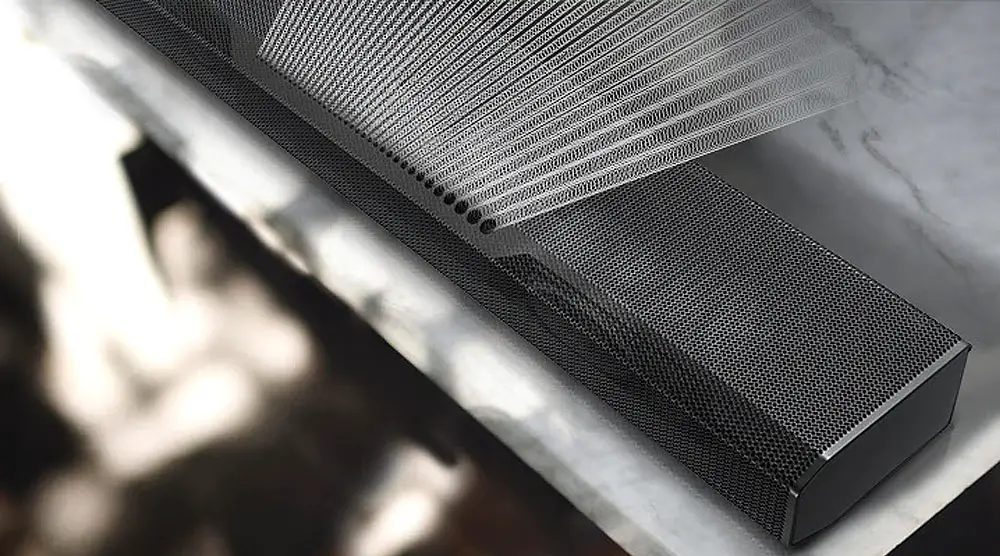
For the two main channels the Q800A is using a single round woofer in combination with an oval one. The center channel uses a single tweeter while for Atmos there are two round woofers.
Last but not least is the subwoofer which includes a side-firing driver which is essentially the same as the one used in the HW-Q950A.
The whole system is rated at 330 watts of output power so let’s brake this number down. The main unit is rated at 170 watts with a (30 W x 4) + (20 W x 2) + 10 W) configuration while the subwoofer comes at 160 watts.
Connectivity
As per usual all inputs are placed on two insets underneath the unit making it a bit hard to reach them all the time. It is mostly aimed to make all connections one time and leave it be.
What we get is not actually so much different than what Samsung offers in many of their soundbars. In one inset we find the two HDMI ports available while on the other there is a micro-USB for service only, a digital optical input and a round power connector. By having both input and output HDMI means that the unit can be used to pass-through any signals but it cannot be used as a hub as there is only one input.
So in case you have multiple input sources you have to be creative with how you connect everything by either using your TV’s multiple HDMI ports or going for a HDMI switch.
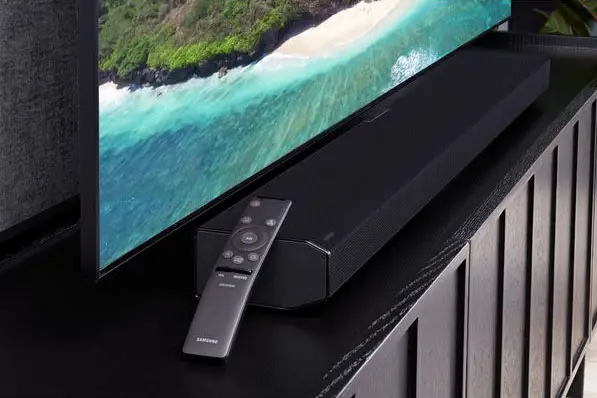
The HDMI output supports both ARC and eARC meaning that you can pass-through all kinds of audio from the TV including Dolby Atmos and DTS:X if your TV supports such functionality. The HDMI ports also support both Dolby Vision and HDR10+ pass-through in case you worry about that. In terms of wireless capabilities the unit comes with both WiFi and Bluetooth connections although we don’t have more specific information about these two.
As it was with the Q700A, the HW-Q800A’s single HDMI input doesn’t leave you with a lot of options in terms of connections. This means that in a full home theater system with many input sources you will have to resort to the TV HDMI inputs and use the ARC/eARC connectivity to pass the audio to the soundbar which is not always the optional way as we have seen more than a few times various problems with eARC connections.
Control Options
Next we will be looking at all the control options available in the HW-Q800A. First the built-in control buttons. There are four touch sensitive buttons and from left to right we find a multi-function button, volume controls and a microphone control button.
Using touch sensitive buttons certainly looks nice but trying to find them in a dark environment can be a frustrating procedure. Also touch sensitive buttons can become less sensitive to touch over time so it has its pros and cons going for such a design decision.

As always, the most obvious means of control is no other than the included remote and here we find no other than the familiar One Remote that Samsung has been using on a wide range of their visual and audio devices. And while general design and buttons layout remain fairly unchanged what has obviously changed is the functionality of these buttons.
The two buttons above the navigation controls are used for source selection and Bluetooth pairing while the other three below the circular navigation controls are for sound mute, sound mode selection and sound control which includes many sound calibration options like treble, bass, frequency bands adjustment and specific channels volume control. The two buttons at the bottom are for main volume on the left and woofer volume on the right.
All Samsung soundbars feature the same One Remote and depending on their functions the buttons have additional uses so if you have used any TV or soundbar from Samsung in recent years the remote will feel very familiar.
The soundbar supports HDMI-CEC which means that if you connect the unit to the TV with a HDMI cable you can use the TV’s remote to handle some basic controls like volume. This may not give you the complete range of supported functions but it may help in certain situations.
Also due to the inclusion of a built-in WiFi module we get Amazon Alexa in order to control the soundbar without the need of a remote but unfortunately there is no Google Assistant which is a bummer. The difference here compared to the HW-Q700A is that while that unit could support Alexa with an external device the HW-Q800A has Alexa built-in the unit and can be used without the need for an Alexa external device.
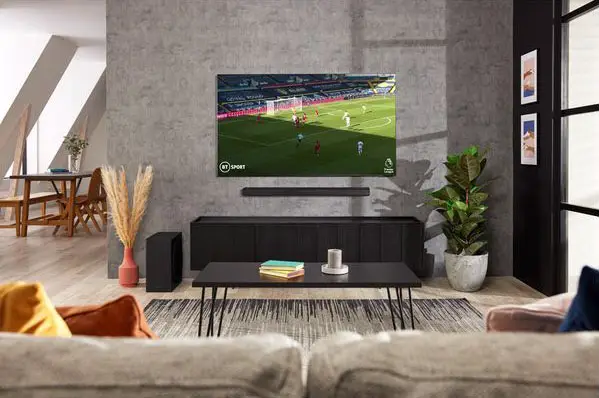
Lastly the soundbar supports the SmartThings app and you can download it to your mobile device and control the unit through that. But although you can use the app to issue basic commands like input selection, volume control and change sound modes it doesn’t have the ability to change some of the more advanced settings like specific channel volume calibration and you will need the remote for that. Also the SamrtThings apps is required for the Alexa to function.
The HW-Q800A is very similar to the HW-Q700A with the only addition being the built-in inclusion of Amazon’s Alexa. We still miss Google Assistant which is unacceptable in this day and age but other than that the Q800A comes with everything you would expect it to.
Extra Features and Services
Next we will be looking at all the extras Samsung included in this one which is not all that different from what we saw in the HW-Q700A. In terms of audio the unit gets extensive support as it can playback Dolby 5.1ch, Dolby Digital Plus, Dolby True-HD, Dolby Atmos, DTS 5.1ch, DTS-HD, DTS-HD Master Audio, DTS:X and LPCM 8Ch.
The unit also comes with a few sound modes you can select from as per usual with most Samsung soundbars. The ones available are the Standard mode which outputs the original audio mix as it is, Surround Sound that provides a more wide sound field than the Standard mode, Game Pro mode which provides stereoscopic sound to immerse you in the action while gaming and Adaptive Sound which analyzes the content audio and provides the optimal sound field accordingly.
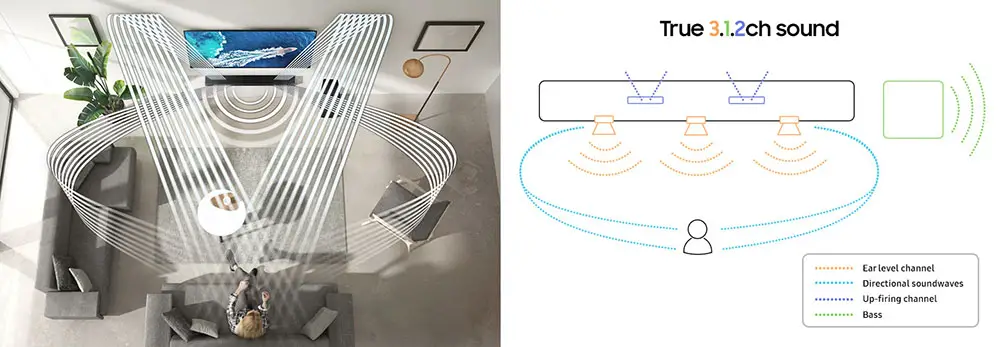
One thing we should note here is that with the Standard mode if you feed the soundbar with a 5.1 channels signal you will only get up to 3.1 channels of output as the up-firing channels will be disabled. Only in Surround, Game Pro or Adaptive sound modes you get the full 3.1.2 channels from the unit. When a Dolby Atmos or DTS:X signal is detected then all 3.1.2 channels are enabled.
The Q800A also comes with Bluetooth connectivity. First of all you have the ability to stream audio from any mobile device through a Bluetooth connection. Also if you don’t want to mess with cables you have the ability to connect it to your TV through Bluetooth if your TV also can support such a connection. Just keep in mind that you cannot have both your TV and a mobile device connected at the same time. It’s either the TV or a Bluetooth device at a time.
Also when you connect your TV with the soundbar through Bluetooth you can stream only stereo audio as Bluetooth cannot sustain higher bandwidth that surround audio formats require.
Lastly there is a Bluetooth Auto Power ON/OFF function. The unit will turn on or off automatically depending on the state of its Bluetooth function. When it detects an incoming Bluetooth signal it will power on while if no Bluetooth signal is detected for a period of time it will turn of automatically.
As for audio decoding we get the usual MP3, WMA, AAC and OGG when it comes to low quality ones but we also get High Resolution Audio support for FLAC, ALAC, AIFF and WAV files. What is disappointing is that there is no USB available in order to playback these files from the unit itself. This means you have to rely to an external source like a media player that supports these or through Bluetooth or WiFi but in this case the quality will certainly be much lower than it could.

The unit also gets Airplay 2 support which is a feature that now has become standard in many Samsung soundbars. With this you can stream music from any Apple device with the use of third party streaming services. If you are an Apple guy then you will surely find this one handy.
Any premium soundbar should offer hands free voice control and the Q800A does come with built-in Amazon Alexa support. But we are disappointed that there is still no Google Assistant which is unacceptable since many dirty cheap units already support both.
Another fancy feature we find is Tap Sound and with it you can mirror music from your phone to your soundbar with just a tap. Obviously your mobile device has to support this feature also but with it you save yourself the trouble of going through the connection process each time. Nothing major but a nice little feature to have.
We also find Samsung’s Q-Symphony feature. If your TV also supports this then the soundbar and the TV sync together in order for both to output sound from all available speakers. This way the TV takes an active part into the sound reproduction in order to up the immersion even further.
Lastly the HW-Q800A is compatible with the SWA-9500S surround speakers kit in case you want to add surround immersion to your setup. We like that Samsung gives you the option for this as you can buy the main unit and decide later if you need this or not. These surround speakers appear to have dual drivers, one working for the surround channel and one for the up-firing Atmos. As such with the inclusion of this kit you can get up to 5.1.4 channels of audio.
Having already experienced the Q700A, the HW-Q800A is not all that different. We welcome the inclusion of Amazon Alexa without the need of an external device but the missing Google Assistant and no USB playback are two features we would like to have.
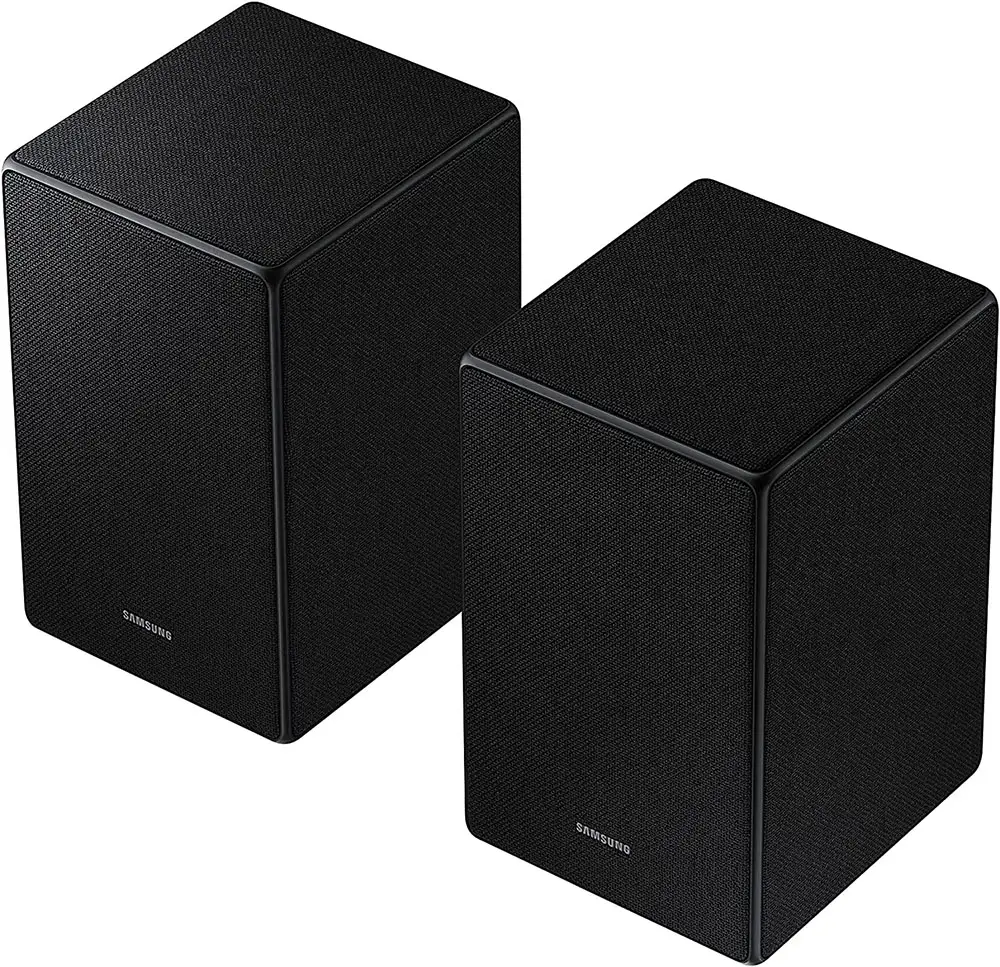
Initial Setup
When it comes to connecting the soundbar, Samsung made sure to give you a lot of flexibility. If you prefer to go the wired route you can either use the HDMI connection either in a pass-through configuration or at the end of the chain with the use of the ARC/eARC functionality. There is also an optical port in case your devices does not have an HDMI port.
But the soundbar also offers you the option to connect it to the TV through a wireless connection. This can be achieved either through Bluetooth or with WiFi but to be honest we would suggest such a connection only if a wired solution is absolutely out of the question. Wireless connections are not so stable and you may have problems with such one. And with Bluetooth you can only get stereo audio so you will be constraining the unit’s performance this way.
After you connect all parts to the appropriate power outlets then both the subwoofer and main unit should pair automatically. If for some reason they don’t then you have the option to do it the manual way and there are very clear and easy instructions on how to do that.
Another feature that was missing from many 202o’s releases was an auto room calibration system and for 2021 it seems that Samsung decided to include one for some of their mid and top tier units. So in the HW-Q800A we find Samsung’s SpaceFit Sound. We have seen this feature in some of the higher tier Samsung TVs which uses a special sensor in order to analyze your room and calibrate the audio output accordingly.
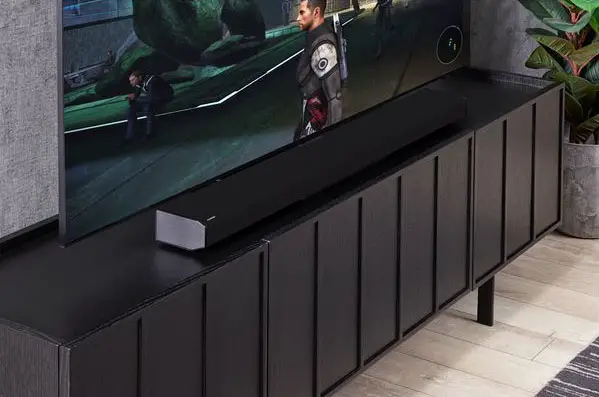
Keep in mind that the version we get in the Q800A is a more simplified version compared to the SpaceFit+ Sound calibration we saw in the Q950A. Also in order for this to work you need to have a Samsung TV that also comes with the same tech which is the Q70 and above.
The soundbar also comes with some basic sound settings but don’t expect anything complicated. There is the usual treble and bass calibration along with a EQ graphic for more detailed frequency manipulation. You can also adjust the volume of each channel to bring them all to equal level.
The last thing you have to do is select the appropriate sound mode. Here you can either choose one according to the material being played or if you are the kind of person that just wants to leave the settings alone then you can use the Adaptive mode and let the soundbar determine the best audio mode to be used each time.
Overall the HW-Q800A offers the same simplicity most Samsung soundbars do. It has enough features and options but not so much to make things feels cluttered and over-complicated for the casual user.
Movies
For this review we decided to try out the new Ghostbusters: Afterlife that is due to release officially in a few days and comes with a lovely Dolby Atmos mix. For anyone that hasn’t seen the film it’s a nice sequel to the original films and a far better movie to the 2016 release.
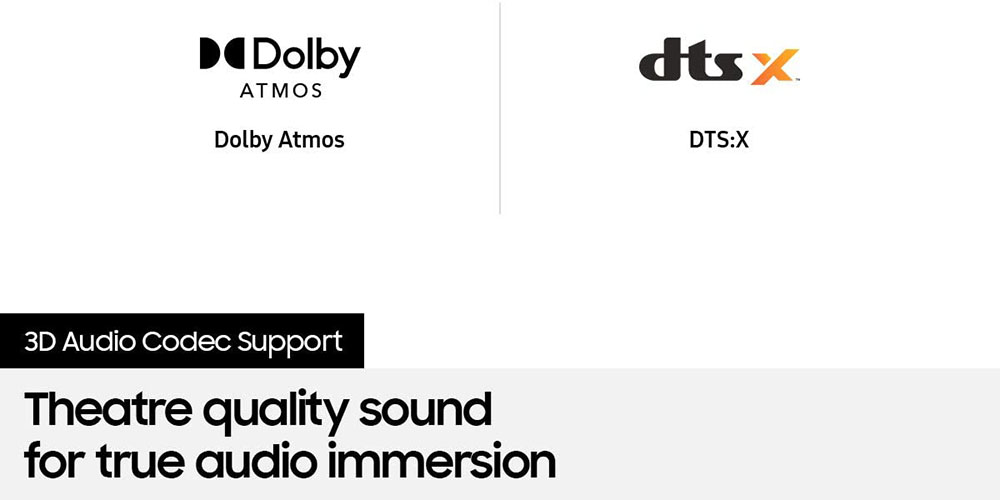
Now as for how the soundbar sounded, the film is very forward oriented but it has its fare share of surround and Atmos activity, mostly towards the latter part of the film. The front stage gained enough energy and spacing, much more than what our TV would ever be able to offer. Even without side-firing drivers the Q800A managed to enlarge the sound wall in front of us in a very convincing manner.
As was the case with the Q700A, the HW-Q800A has no surround speakers in the box so in terms of surround activity it surely missed the mark. Every sound and source position came directly from the front. There was no sense of side activity or behind-the-shoulder action. There was some obvious side extension and greater sound volume that would make you feel like sound is closer to your position but ultimately if you really want real surround action the optional surround kit is a must.
As for the Atmos effects although there were not many of them in this film and most of them were more subtle they surely added to the overall immersion. During the initial confrontation with the first ghost you can hear some nice overhead effects that really adds to the overall atmosphere.
The Atmos performance of the Q800A, although definitely there, was not as defined or clear as we were hoping to. Obviously such a soundbar is not meant to be the epitome of Atmos performance but we have heard of soundbars with more defined overhead activity. Also keep in mind that with up-firing Atmos systems room design plays a big role in how you will perceive ceiling bouncing sounds.
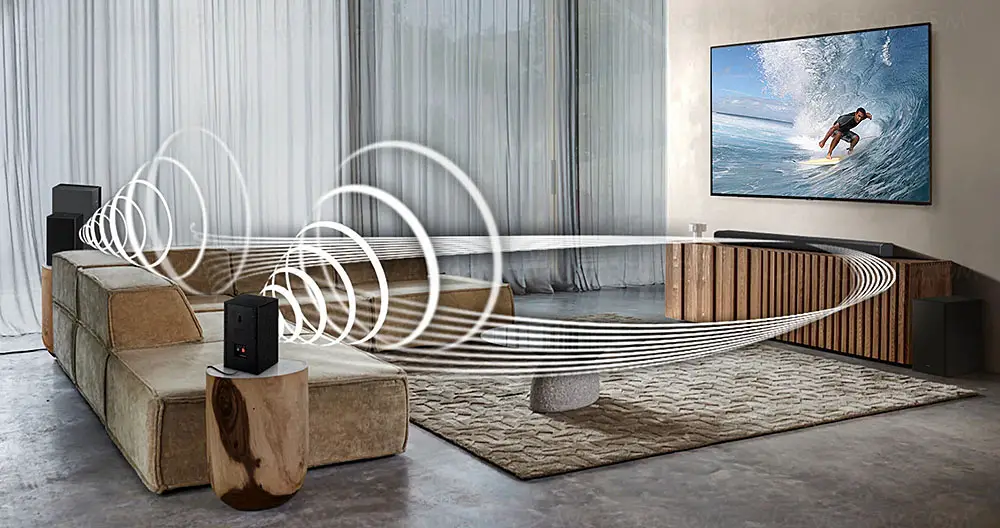
A low, straight ceiling will help to make the Atmos effects more distinct while the higher the ceiling the more you are going to loose in upwards extension and fidelity. So keep in mind that if you want decent performance then the ceiling shouldn’t be higher than 3 meters, even lower if possible.
Lastly a film like Ghostbusters surely has its fare share of low end mayhem. Here things were much better than what we remembered in our Q700A and this partly has to do with the different subwoofer being utilized. The one that comes with the Q800A felt more powerful, with more shaking prowess, more defined low end and overall you could sense it could dig deeper making the whole experience just better.
Once again we tested the various sound modes the soundbar comes with and to be honest we really liked the Adaptive mode as it was not only capable at delivering a very nice cinematic experience but also allows you to really forget about changing modes all the time as the soundbar will adjust its output depending the content on screen.
With the adaptive mode our viewing session of Ghostbusters: Afterlife gave us very distinct dialogue that was nicely isolated and center positioned, nice energy at the front stage, some side and depth extension, lovely Atmos activity and exciting bass.
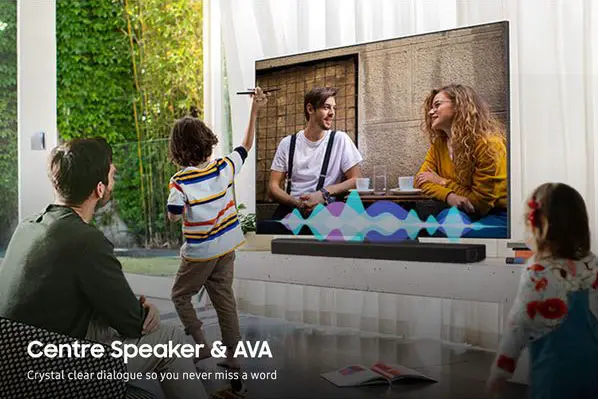
The Q800A is a soundbar that knows what it can offer you and will never feel like it tried to bite more than it can chew. It may not be the soundbar that will drop your jaw on the floor by its performance but it was never really meant to do this. It will provide a very obvious upgrade over what your TV can do and if you can add the extra surround kit you will have a very decent full surround system that is more than enough if you are not a very demanding user.
Music
For our music testing, since there is no USB playback support, we decided to use an external media player that we connected through the HDMI port. We decided to avoid using a wireless connection as the quality certainly lacks in comparison.
The soundbar performed as any soundbar of its class would. Satisfying and vibrant front stage with good sound imaging and some nice stereo panning effects. It was not the most defined of performances and certainly there was a certain lack of clarity but if you don’t try to pay too much attention to details then you will surely forget about this pretty fast.
If you leave the soundbar in Adaptive mode then even stereo mixes will output in all the available channels. This means that the output may feel a bit strange or different than intended but this really depends on the song and your preference. In Standard mode we got the normal 2.1 channels output and it surely felt more close to the original performance but we can honestly say we liked both but for different songs and different genres.

The high frequencies had good energy without becoming over-exiting or bothering. The vocals were distinct and the center channel did a good job at keeping everything isolated from the rest of the performance.
As for the bass the soundbar did good enough with most songs we threw at it. The bigger subwoofer utilized here could push deeper and give you the sense of better handling of the low frequencies. There were moments when the performance of the Q700A felt a bit uninspiring, not so much here as the sub would continue to hit us with low end waves and keep the momentum going.
As always we tested a few different genres just to get an idea of how the soundbar can do in different conditions. And so we tried various content from classical, jazz, some electronic, a bit of rock and even some opera for good measure. The Q800A behaved as you would expect from a device of this price.
There were not any glaring irregulates to be concerned about, but the soundbar is not going to break any high fidelity records any time soon. It’s good for providing a great audio experience either it is movies or music you are going to use it for and what it does, it does good. So if you know what the soundbar can offer and don’t expect any miracles then it will satisfy with its performance for sure.
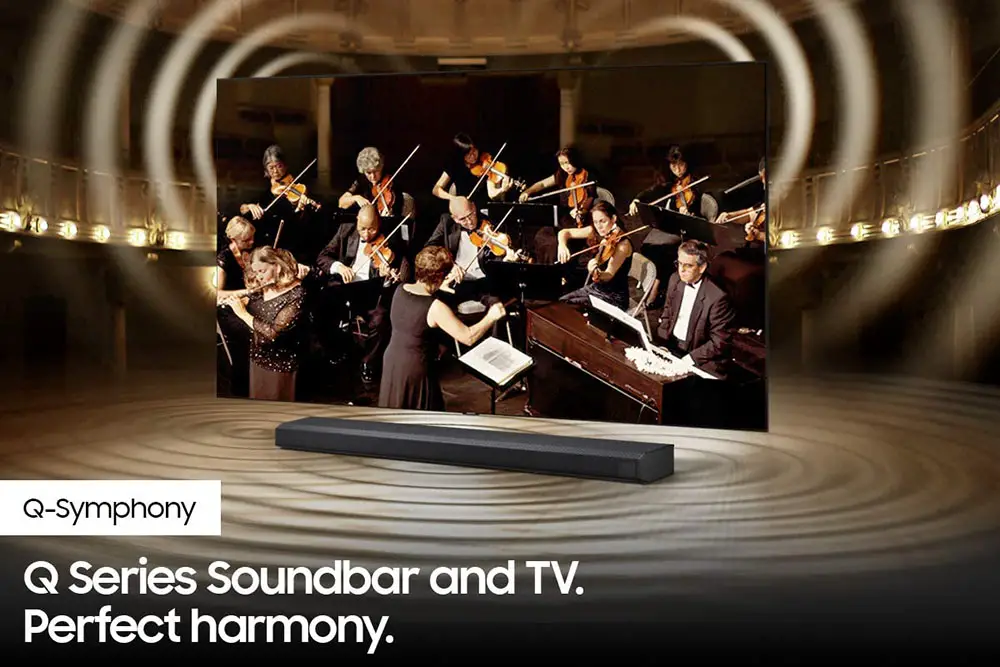
Final Thoughts
If there was one thing where we felt the Q700A really underperformed that was in its bass and the Q800A we have here seems to have addressed that by incorporating the subwoofer that is used in the Q950A. So in essence the HW-Q800A is a combination of the Q700A’s main unit with the Q950A’s subwoofer. Add in a few minor changes and additions and there you have the Q800A.
The soundbar can do really good in all kinds of audio material either this is movies or music. Don’t expect HiFi type of quality but Samsung’s standards ensures its quality would be above average. We liked that the low is improved compared to the Q700A and overall it felt like a slightly more satisfying experience but don’t expect vast changes. If you add all the additional features and expandability to a full 5.1.4 channels system with the inclusion of the optional surround kit then the Q800A has something for everyone to offer.
As for its downsides, well these are the same as what we observed during our Q700A testing. The SmartThings app does not offer you the ability to change some of the soundbar settings like separate channels volume. We also would like to have Google Assistant along with Alexa as many dirty cheap soundbars offer both nowadays and the omission of a USB that can be used to connect external storage and playback music that way is one hopefully will be rectified in the future. Lastly if you want to have any meaningful surround activity then the optional surround kit is a must which will add to the overall cost.
The Samsung HW-Q800A feels like an improved Q700A. It has better low end and slightly better overall performance while the addition of Amazon Alexa ups its value slightly. It’s not a night and day difference but it improves where it matters and surely will find its audience among the other Samsung soundbar releases of 2021.
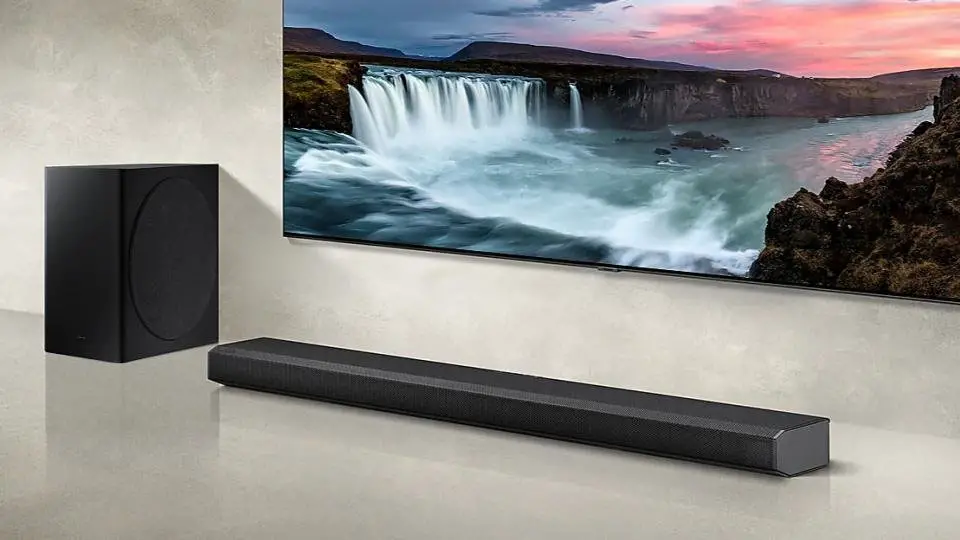
For more reviews you can check our dedicated Soundbar-subwoofer combo reviews list or even look at our Product Reviews Table where you can find the brand and specific product you are looking for.
Cheapest Places to Buy :
*We are a reader-supported website. When you buy through links on our site, we may earn a small affiliate commission at no extra cost to you. Home Media Entertainment does not accept money for reviews.*
I have been eyeing the Samsung soundbars they have for 2021 and they are pretty good in my opinion. But I wouldn’t be able to do without surrounds so the extra kit is a must for me. It’s a pity that it is not included in the box, it would have made a great bundle.
Thank you for sharing.
Surely with the surround it would be better but keep in mind that not everyone has the space for them. So for many people these would be useless. So Samsung decided to make them optional for those that really want them and I think this is the best solution for both worlds.
Hi Stratos
Thank you for the very detailed review on Samsung HW-Q800A.
Although it is a little bit pricey I have been considering the Q800A for some time now but to be honest I couldn’t make up my mind. This is going to be my first Dolby Atmos soundbar so I am still considering my options.
It’s not a bad choice for being your first Atmos soundbar. There are many options out there close to this price range so if you need any further assistance in order to choose let me know.
Hi Stratos,
Have been following your reviews for some time now. I have been looking at picking one of the Samsung soundbars. Was initially considering the Q600A( the Q700A is not available in India). But as you have rightly mentioned, after hearing the subwoofer of the Q800A it made me change my mind. And to top it off, I got a good deal for about $450. So just grabbed it.
Thanks and keep up the good work.
I am glad that our articles were able to help you make your choice. If you need any further help don’t hesitate to write in the comments. Have a very nice day and enjoy your new soundbar!